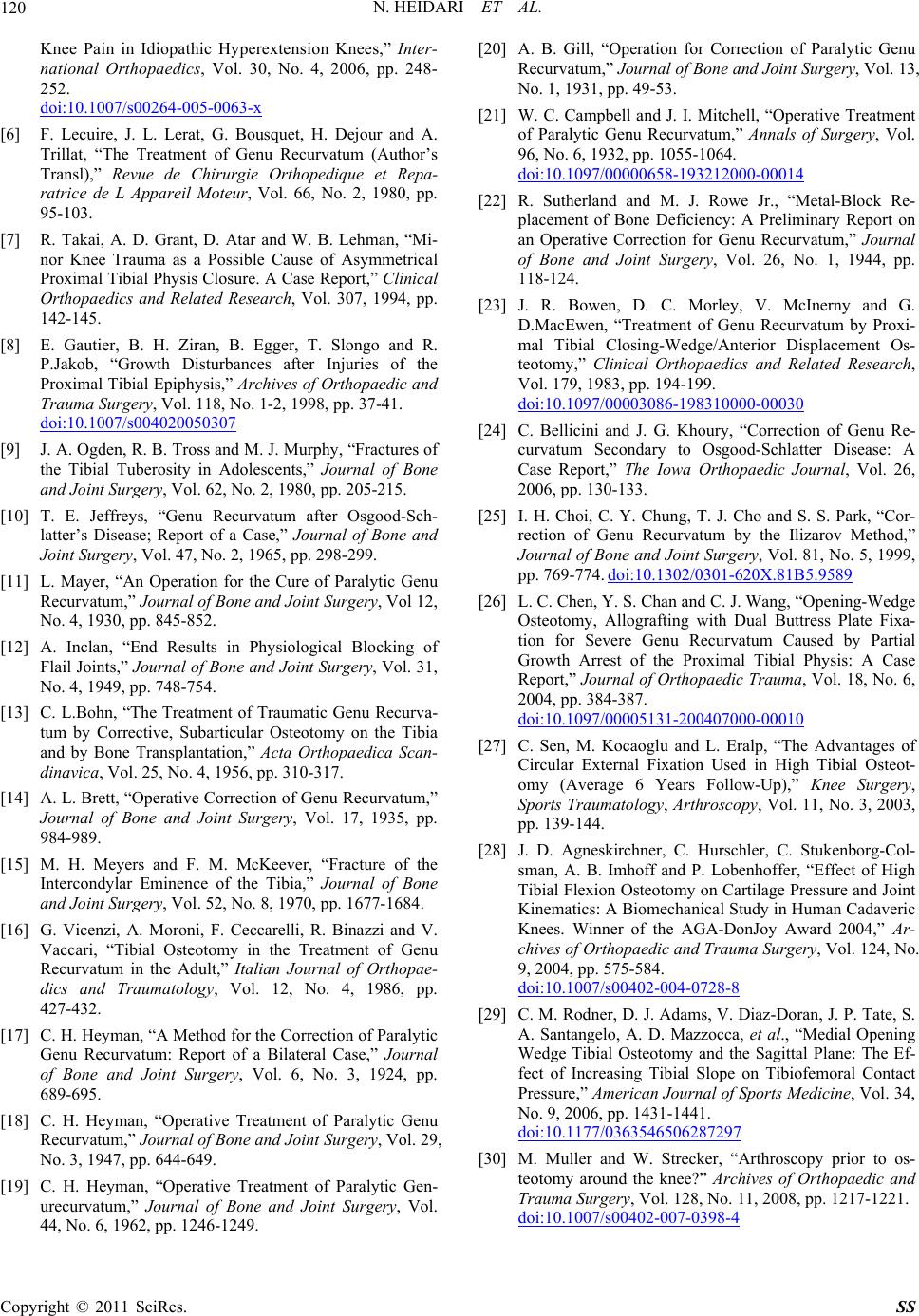
N. HEIDARI ET AL.
Copyright © 2011 SciRes. SS
120
Knee Pain in Idiopathic Hyperextension Knees,” Inter-
national Orthopaedics, Vol. 30, No. 4, 2006, pp. 248-
252.
doi:10.1007/s00264-005-0063-x
[6] F. Lecuire, J. L. Lerat, G. Bousquet, H. Dejour and A.
Trillat, “The Treatment of Genu Recurvatum (Author’s
Transl),” Revue de Chirurgie Orthopedique et Repa-
ratrice de L Appareil Moteur, Vol. 66, No. 2, 1980, pp.
95-103.
[7] R. Takai, A. D. Grant, D. Atar and W. B. Lehman, “Mi-
nor Knee Trauma as a Possible Cause of Asymmetrical
Proximal Tibial Physis Closure. A Case Report,” Clinical
Orthopaedics and Related Research, Vol. 307, 1994, pp.
142-145.
[8] E. Gautier, B. H. Ziran, B. Egger, T. Slongo and R.
P.Jakob, “Growth Disturbances after Injuries of the
Proximal Tibial Epiphysis,” Archives of Orthopaedic and
Trauma Surgery, Vol. 118, No. 1-2, 1998, pp. 37-41.
doi:10.1007/s004020050307
[9] J. A. Ogden, R. B. Tross and M. J. Murphy, “Fractures of
the Tibial Tuberosity in Adolescents,” Journal of Bone
and Joint Surgery, Vol. 62, No. 2, 1980, pp. 205-215.
[10] T. E. Jeffreys, “Genu Recurvatum after Osgood-Sch-
latter’s Disease; Report of a Case,” Journal of Bone and
Joint Surgery, Vol. 47, No. 2, 1965, pp. 298-299.
[11] L. Mayer, “An Operation for the Cure of Paralytic Genu
Recurvatum,” Journal of Bone and Joint Surgery, Vol 12,
No. 4, 1930, pp. 845-852.
[12] A. Inclan, “End Results in Physiological Blocking of
Flail Joints,” Journal of Bone and Joint Surgery, Vol. 31,
No. 4, 1949, pp. 748-754.
[13] C. L.Bohn, “The Treatment of Traumatic Genu Recurva-
tum by Corrective, Subarticular Osteotomy on the Tibia
and by Bone Transplantation,” Acta Orthopaedica Scan-
dinavica, Vol. 25, No. 4, 1956, pp. 310-317.
[14] A. L. Brett, “Operative Correction of Genu Recurvatum,”
Journal of Bone and Joint Surgery, Vol. 17, 1935, pp.
984-989.
[15] M. H. Meyers and F. M. McKeever, “Fracture of the
Intercondylar Eminence of the Tibia,” Journal of Bone
and Joint Surgery, Vol. 52, No. 8, 1970, pp. 1677-1684.
[16] G. Vicenzi, A. Moroni, F. Ceccarelli, R. Binazzi and V.
Vaccari, “Tibial Osteotomy in the Treatment of Genu
Recurvatum in the Adult,” Italian Journal of Orthopae-
dics and Traumatology, Vol. 12, No. 4, 1986, pp.
427-432.
[17] C. H. Heyman, “A Method for the Correction of Paralytic
Genu Recurvatum: Report of a Bilateral Case,” Journal
of Bone and Joint Surgery, Vol. 6, No. 3, 1924, pp.
689-695.
[18] C. H. Heyman, “Operative Treatment of Paralytic Genu
Recurvatum,” Journal of Bone and Joint Surgery, Vol. 29,
No. 3, 1947, pp. 644-649.
[19] C. H. Heyman, “Operative Treatment of Paralytic Gen-
urecurvatum,” Journal of Bone and Joint Surgery, Vol.
44, No. 6, 1962, pp. 1246-1249.
[20] A. B. Gill, “Operation for Correction of Paralytic Genu
Recurvatum,” Journal of Bone and Joint Surgery, Vol. 13,
No. 1, 1931, pp. 49-53.
[21] W. C. Campbell and J. I. Mitchell, “Operative Treatment
of Paralytic Genu Recurvatum,” Annals of Surgery, Vol.
96, No. 6, 1932, pp. 1055-1064.
doi:10.1097/00000658-193212000-00014
[22] R. Sutherland and M. J. Rowe Jr., “Metal-Block Re-
placement of Bone Deficiency: A Preliminary Report on
an Operative Correction for Genu Recurvatum,” Journal
of Bone and Joint Surgery, Vol. 26, No. 1, 1944, pp.
118-124.
[23] J. R. Bowen, D. C. Morley, V. McInerny and G.
D.MacEwen, “Treatment of Genu Recurvatum by Proxi-
mal Tibial Closing-Wedge/Anterior Displacement Os-
teotomy,” Clinical Orthopaedics and Related Research,
Vol. 179, 1983, pp. 194-199.
doi:10.1097/00003086-198310000-00030
[24] C. Bellicini and J. G. Khoury, “Correction of Genu Re-
curvatum Secondary to Osgood-Schlatter Disease: A
Case Report,” The Iowa Orthopaedic Journal, Vol. 26,
2006, pp. 130-133.
[25] I. H. Choi, C. Y. Chung, T. J. Cho and S. S. Park, “Cor-
rection of Genu Recurvatum by the Ilizarov Method,”
Journal of Bone and Joint Surgery, Vol. 81, No. 5, 1999,
pp. 769-774. doi:10.1302/0301-620X.81B5.9589
[26] L. C. Chen, Y. S. Chan and C. J. Wang, “Opening-Wedge
Osteotomy, Allografting with Dual Buttress Plate Fixa-
tion for Severe Genu Recurvatum Caused by Partial
Growth Arrest of the Proximal Tibial Physis: A Case
Report,” Journal of Orthopaedic Trauma, Vol. 18, No. 6,
2004, pp. 384-387.
doi:10.1097/00005131-200407000-00010
[27] C. Sen, M. Kocaoglu and L. Eralp, “The Advantages of
Circular External Fixation Used in High Tibial Osteot-
omy (Average 6 Years Follow-Up),” Knee Surgery,
Sports Traumatology, Arthroscopy, Vol. 11, No. 3, 2003,
pp. 139-144.
[28] J. D. Agneskirchner, C. Hurschler, C. Stukenborg-Col-
sman, A. B. Imhoff and P. Lobenhoffer, “Effect of High
Tibial Flexion Osteotomy on Cartilage Pressure and Joint
Kinematics: A Biomechanical Study in Human Cadaveric
Knees. Winner of the AGA-DonJoy Award 2004,” Ar-
chives of Orthopaedic and Trauma Surgery, Vol. 124, No.
9, 2004, pp. 575-584.
doi:10.1007/s00402-004-0728-8
[29] C. M. Rodner, D. J. Adams, V. Diaz-Doran, J. P. Tate, S.
A. Santangelo, A. D. Mazzocca, et al., “Medial Opening
Wedge Tibial Osteotomy and the Sagittal Plane: The Ef-
fect of Increasing Tibial Slope on Tibiofemoral Contact
Pressure,” American Journal of Sports Medicine, Vol. 34,
No. 9, 2006, pp. 1431-1441.
doi:10.1177/0363546506287297
[30] M. Muller and W. Strecker, “Arthroscopy prior to os-
teotomy around the knee?” Archives of Orthopaedic and
Trauma Surgery, Vol. 128, No. 11, 2008, pp. 1217-1221.
doi:10.1007/s00402-007-0398-4